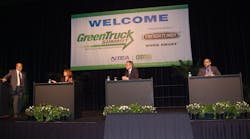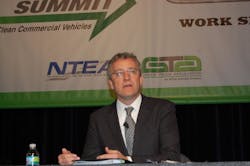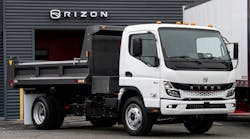INDIANAPOLIS. When it comes to the adoption of zero emission vehicles (ZEVs), many questions abound. Is there enough infrastructure for trucks to refuel? What are the estimated lifecycles of ZEVs compared to combustion engines? What are some incentives to retire older trucks? And so on.
Those questions were answered during a panel on government objectives for zero-emission transportation during Tuesday’s Green Truck Summit at the 2017 National Truck Equipment Association (NTEA) Work Truck Show.
According to Reuben Sarkar, deputy assistant secretary for transportation at the U.S. Department of Energy (DOE), DOE is working with OEMs and states across the country to help drive the adoption of ZEV infrastructure. As far as maintenance and estimated lifecycles go, Jack Kitowski, division chief of mobile source control division for the California Air Resources Board (CARB), said since components in electric vehicles are so much simpler than combustion engines, there is much less maintenance required.
Since California has the worst air quality in the country when it comes to federal ozone standards and smog, Kitowski noted the main driver behind implementing zero-emission technologies is to reduce greenhouse gas (GHG) emissions by 80% by 2050.
“We’ve reduced localized emissions and diesel particulate emissions filters have done a great job in cleaning up the soot that comes out of trucks, but we need to do more,” Kitowski said, noting that diesel emissions are highest around ports and transportation hubs.
A 2016 ZEV action plan identifies the actions California would take to deploy 1.5 million ZEVs by 2025 in both the light- and heavy-duty sectors. The state’s long-term freight plan includes transitioning to ZEVs and increasing penetration of the first-wave of zero-emission heavy-duty technology. It also includes focusing on ideal candidates for zero-emission HD vehicle regulations – zero-emission transit buses, last-mile delivery and local trucks, and zero-emission airport ground transportation.
“When we look at regulatory measures going forward, we see a lot of opportunities in these sectors,” according to Kitowski. “Lifecycle emissions of electric vehicles are lower than their counterparts of diesel and natural gas.”
He added that this year, CARB has provided over $4 billion in incentives in clean technology over the last four years.
DOE is using a three-tiered approach when looking at ZEV technology: fuel diversification, vehicle efficiency energy, and mobility systems. According to Sarkar, ZEV drivers include:
- Falling technology costs – take an engine today, you can make it more efficient, but it costs more money.
- Modern grid – bringing a lot more clean electrons on from renewable resources and more ways to connect to the grid.
- Increasing urbanization – more and more people moving into cities. More congestion and higher need to address the issues related to that.
- Changing consumer preferences
- Rise of Connected and Automated Vehicles
- Emergence of New Mobility Models
- Global Imperatives
“The primary source for ZEVs today is getting clean electrons,” Sarkar said. “We’re experiencing a revolution now in clean energy. We are seeing a repeating trend happening.”
He noted that though the cost of batteries has been falling – from more than $1,000/kWh down to $250/kWh today – that even a goal of reaching $125/kWh by 2022 isn’t good enough due to low gas prices. Yet Sarkar explained the cost will have to go down to at least an $80/kWh battery, and that it will take another decade to get there.
“I think when most people think about the lifecycle they think about battery replacements,” he added. “The number of brake repairs [for ZEVs] are dramatically lower. I think the lifecycle will be equivalent or better than a combustion engine equivalent because there will be less maintenance. I think the risk is low, which is what I think most people think about when trying to compare the two.”






